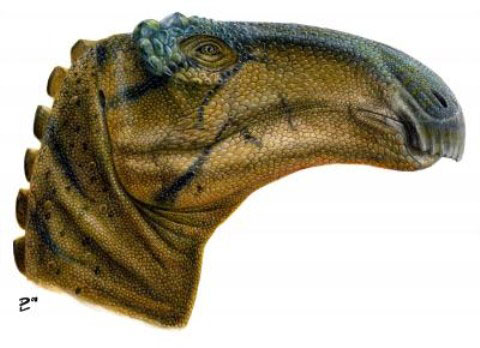Discovered a more herbivorous dinosaur
Paleontologists at the University of Pennsylvania have discovered a new herbivorous dinosaur based on a skeleton discovered in western New Mexico state (USA).
Their incomplete skeletons include graves of skulls, several lumbar vertebrae and small pieces of ribs. By specialized methods, the new dinosaur species has a scientific name is Jeyawati rugoculus , living mainly in the swamp forest ecosystem. They are most developed along inland beaches 91 million years ago.
The name of the new dinosaur means 'creaking mouth and wavy eyes'. They are herbivores, the food is mainly ancient ferns and conifers.

Images are experts simulating new herbivorous dinosaurs.
The Jeyawati species are closely related to the previously discovered duck beak dinosaur hadrosaur, which is common in the Northern hemisphere during the late Cretaceous period, about 65-80 million years ago. According to the simulation, Jeyawati also retains many of the original characteristics of teeth and jaws of the dinosaur hadrosaur.
The word Jeyawati is pronounced in two hours in the language of the Zuni - an indigenous American race, living along the river Zuni, west of New Mexico. This name relates to the evolved complex chewing apparatus of herbivores.
The second part of the name dinosaur, rugoculus , is a Latin word, consisting of ruga and oculus , meaning wavy eyes. It describes the unique function of this new dinosaur. One of the bones that holds its pores forms a concave outer appearance, which can help this species have a wider view in the front and back of the eye.
Dr. Andrew Mc.Donald, the leader of the study, commented: 'The new dinosaurs seem to endure a very difficult life. Some broken ribs show signs of swelling and rough surfaces. That said, this animal has been hurt or broken ribs several times in life. The damage has recovered before the animal dies. '

Fossil bone samples of new dinosaurs, including a part of the skull, burning the spine and fragments of the ribs.
Fossils of new herbivorous dinosaurs have been discovered since 1996. But until this discovery, Jeyawati was classified as an unclassified dinosaur and animal for nearly 15 years.
According to Mr. Donald, based on the fossils collected, we can assume that dinosaurs go by four limbs, but are also able to stand on the two limbs.
The bones of Jeyawati were taken to Arizona Natural History Museum (USA) to keep with many newly discovered dinosaur samples in the area. Among them is the horned zuniceratops , or a strange monster that feeds on Nothronychus .
Source: Science Daily
- Find the 'super small' skull of the giant herbivorous dinosaur
- Herbivorous dinosaurs received ancestors
- Finding dinosaurs with nose
- New Australian herbivorous dinosaurs found 15 meters long and weighed nearly 20 tons
- Series of dinosaur footprints revealed after storm in England
- The largest fossil dinosaur skeleton discovered
- Monster monster filled with prickly horns on the face
- Discovered a giant dinosaur skeleton that has a lifespan of 70 million years
- Fossils alter the perception of feather dinosaurs
- Discovered new dinosaurs in South Africa
- Fossils of Thailand's largest dinosaur have just been found
- Discovered 2 new dinosaurs that hurt archaeologists
 Discovered an ancient centipede fossil 99 million years old
Discovered an ancient centipede fossil 99 million years old Discovered bat-like dinosaurs in China
Discovered bat-like dinosaurs in China Discovered a 200-year-old bronze cannon of the coast
Discovered a 200-year-old bronze cannon of the coast Discover 305 million-year-old spider fossils
Discover 305 million-year-old spider fossils Solar panels capture invisible energy at night to produce electricity
Solar panels capture invisible energy at night to produce electricity  British Doctor Reveals How to Make Your Brain '30-50 Years Younger', So Simple Anyone Can Do It
British Doctor Reveals How to Make Your Brain '30-50 Years Younger', So Simple Anyone Can Do It  Discovering more than 2 million new crystal structures, Google's AI shortens 800 years of research for humanity
Discovering more than 2 million new crystal structures, Google's AI shortens 800 years of research for humanity  World's rarest whale carcass washes ashore in New Zealand
World's rarest whale carcass washes ashore in New Zealand  Japan develops breakthrough medicine from... volcano crater
Japan develops breakthrough medicine from... volcano crater  Based on new theory, physics 'captures' a photon for the first time
Based on new theory, physics 'captures' a photon for the first time 